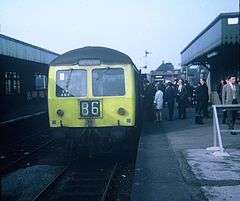British Rail Class 112
| British Rail Classes 112 and 113 | |
|---|---|
|
Last train from Nottingham Arkwright Street, 1969 | |
| In service | 1960–1969 |
| Manufacturer | Cravens |
| Constructed | 1960 |
| Number built |
Class 112: 25 sets (50 cars) Class 113: 25 sets (50 cars) |
| Number scrapped | All |
| Formation | Power-twin: DMBS-DMCL |
| Capacity |
DMBS: 52 second DMCL: 12 first, 51 second |
| Operator(s) | British Rail |
| Specifications | |
| Car length | 57 ft 6 in (17.53 m) |
| Width | 9 ft 3 in (2.82 m) |
| Maximum speed | 70 mph (110 km/h) |
| Weight |
DMBS: 30 long tons 0 cwt (67,200 lb or 30.5 t), DMCL: 30 long tons 0 cwt (67,200 lb or 30.5 t) |
| Prime mover(s) | One Rolls-Royce C8NFLH |
| Power output | 238 hp (177 kW) per car |
| Transmission |
Class 112: Mechanical 4-speed epicyclic gearbox Class 113: Hydraulic |
| UIC classification | (1A)(A1)+(1A)(A1) |
| Braking system(s) | Vacuum |
| Coupling system | Screw-link |
| Multiple working | ■ Blue Square |
| Track gauge | 4 ft 8 1⁄2 in (1,435 mm) |
The Class 112 and Class 113 DMUs used the standard Cravens body used on Class 105s but had a single Rolls-Royce C8NFLH engine rated at 238 hp (177 kW) per car, all of which formed into 'power twins'- two car sets with both vehicles powered.
There were two batches built, the first 50 vehicles (25 sets) had standard mechanical transmission via a gearbox and were allocated the Class 112. The second batch of 50 cars (25 sets) had hydraulic transmission, and became Class 113s.
The cars were built for services in the LMR Central Division and in the Liverpool - St Helens area, where the gradients in the Lancashire & Yorkshire area required more power. Both types also spent some time working from Cricklewood.
The gross weight of a set with all seats occupied was approximately 70 tons, giving 6.8 hp (5.1 kW) per ton. Empty, it was 8.1 hp/ton, which compared favourably with 5.7 hp/ton that the Cravens power/trailer had.
Orders
| Lot No. | Diagram | Car Type | Qty | Fleet numbers | Notes |
|---|---|---|---|---|---|
| 30533 | 602 | Driving Motor Brake Third (DMBS) | 25 | 51681–51705 | Class 112 |
| 30534 | 603 | Driving Motor Composite with lavatory (DMCL) | 25 | 51706–51730 | Class 112 |
| 30535 | 604 | Driving Motor Brake Third (DMBS) | 25 | 51731–51755 | Class 113 |
| 30536 | 605 | Driving Motor Composite with lavatory (DMCL) | 25 | 51756–51780 | Class 113 |
Other technical details
- Coupling Code: Blue Square
- Transmission: Standard Mechanical (Class 112), Hydraulic (Class 113)
Preservation
All 112s and 113s were withdrawn by the end of 1969, and none survive.
References
| Wikimedia Commons has media related to British Rail Class 112. |
- The Railcar Association
- Motive Power Recognition: 3 DMUs. Colin J. Marsden
- British Railway Pictorial: First Generation DMUs. Kevin Robertson
- British Rail Fleet Survey 8: Diesel Multiple Units- The First Generation. Brian Haresnape
- A Pictorial Record of British Railways Diesel Multiple Units. Brian Golding
